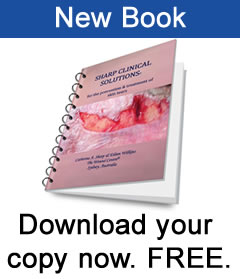At last! A pressure ulcer free aged care facility!
Preventing pressure ulcers in aged care by auditing, and changing, work practices
https://doi.org/10.3126/ajms.v13i4.41855
Abstract
Background: Two nurse consultants concerned with ongoing pressure ulcer development in a 44-bed residential aged care facility in Sydney, Australia, audited pressure ulcers and the use of air mattresses.
Aims and Objectives: To measure and reduce the prevalence of pressure ulcers; audit air mattresses in use; reduce the physical workload for care staff repositioning residents; introduce an alternating pressure air mattress, allow residents to sleep undisturbed, and provide bedside education for all nursing staff.
Materials and Methods: Pressure ulcer prevalence was determined, “air” mattresses were inspected, and repositioning regimes were considered. All residents at risk of pressure ulcers were provided with a “Nodec A” mattress, allowed to sleep undisturbed, and bedside training was given to staff.
Results: Pressure ulcer prevalence was 18.1%. Eight of 44 residents had a total of 10 pressure ulcers; four sacral, three heel ulcers, two buttocks, and one hip. An audit of “air” mattresses showed half, seven of 14 (50%), was not working. Four alarm lights were on; two were set on static mode and one was deflated. Six months after the introduction of the “Nodec A” alternating pressure air mattress all pressure ulcers had healed, and the facility was pressure ulcer free.
Conclusion: Residents nursed on the “Nodec A” were pressure ulcer free and slept for hours without being repositioned and woken.
Sharp Clinical Solutions Download
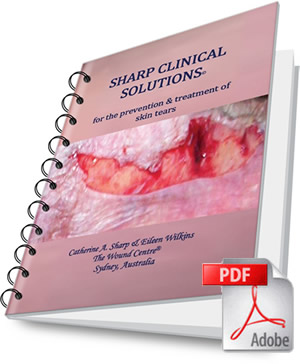 |
||
| Click above to download your copy of the Sharp Clinical Results Book. |
Managing the chronic wound environment with Hydration Response Technology; Excerpt from a case study
Mr S. an elderly, obese, gentleman was admitted for assessment and management of bilateral lateral malleolar leg ulcers. The patient’s legs were grossly oedematous with virtually circumferential, severe, bilateral, sloughy, malodorous, maceration of the peri-wound skin. (Figures 1-3)
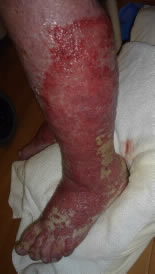 |
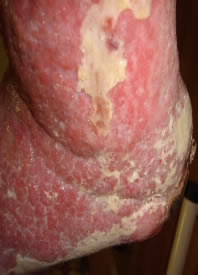 |
|
| Fig. 1 Left leg Day 0 | Fig. 2 Close-up of Left lateral malleolus |
The production of exudates was unrelenting so that dressings and bed linen required at least daily changes and sometimes night changes as well. Dressing change took more than an hour each time to complete, often requiring the assistance of a second nurse.
If a (chronic) wound is to make progress then the barriers to healing need to be identified and addressed. The persistent inflammation that is found in chronic wounds is a consequence of elevated levels of pro-inflammatory cytokines, proteases and neutrophils2. This is often accompanied by elevated production of exudate. The high levels of exudate combined with the pro-inflammatory mediators result in a detrimental effect on healing, including wound enlargement and damage to the peri-wound skin such as maceration and excoriation3. It has been suggested that the wound bed preparation (WBP) model may assist in overcoming these barriers to healing when targeted therapeutic measures are initiated1.
Hydration Response Technology
A recent publication by Evans4 shows how sorbion sachet S utilises the concept of Hydration Response Technology (HRT) and specifically its value in managing infection in a recalcitrant pressure ulcer. Hydration Response Technology was created specifically to meet the challenge of wounds which produce moderate to high levels of exudates.
Clinical performance and related evidence
Hydration Response Technology using sorbion sachet S enables effective wound bed preparation and can lead to a significant reduction of overall treatment costs4,5,6,7. Efficient management of exudates extends beyond mere absorption and includes,:4, 5, 8, 9
|
Table 1
Read the full article and see more photographs of the progress of this gentleman’s leg ulceration in Sharp C.A. Managing the wound environment with Hydration Response Technology. Wounds UK 2010 Vol 6, No 2 and on the website http://www.sorbion.com/en/clinical-data/
References 1. Schultz GS, Barillo DJ, Mozingo DW, et al. Wound bed preparation and a brief history of TIME. Wound Repair and Regeneration 2004; 1(1):19-32. 2. Wolcott RD, Rhoads DD, Dowd SE. Biofilms and chronic wound inflammation. Journal of Wound Care 2008; 17(8):333-341. 3. Nelson A. Is Exudate a Clinical Problem. In: (Eds.) Cherry, G., Harding, K. Proceedings, Joint Meeting, European Wound Management Association and European Tissue Repair Society. Management of Wound Exudate. London:. Churchill Communications Europe 1997. 4. Evans J. Hydration response technology and managing infection. Journal of Community Nursing 2010; 24(1):15-16. 5. Romanelli M, Dini V, Bertone M. A pilot study evaluating the wound and skin care performances of the Hydration Response Technology dressing: a new concept of debridement. Journal of Wound Technology 2009; 5:1-3. 6. Chadwick P. The use of sorbion sachet S in the treatment of a highly exuding diabetic foot wound. The Diabetic Foot Journal 2008; 11(4):183-186. 7. Cutting KF, Acton C, Beldon P, et al. Clinical evaluation of a new high absorbency dressing. EWMA conference, Lisbon 2008; 14-16 May. 8. Cutting KF. Managing wound exudate using a super-absorbent polymer dressing: a 53-patient clinical evaluation. Journal of Wound Care 2009; 18(5):200-205. 9. Armitage M, Macaskill C. Simplifying the management of complex chronic leg ulcers. Poster presentation – Wounds-UK 2009; Harrogate.Wound care for a facial ulcer; a case study.
Introduction
Wound care for facial ulcers can be challenging. The site of the ulcer; appearance; social factors; pain control; availability of wound dressings; amount of exudates and patient tolerance, all impact on the choice and combination of dressings.
Ulcers on the face are often very difficult to dress for several reasons:
- Patients don’t want to see the ulcer;
- They want the ulcer to be ‘hidden’;
- At the same time they want to look reasonable for their family & visitors;
- Discrete dressings are the obvious choice…but what?;
- It is difficult to disguise ulcers as they get larger and deeper;
- Ulcers may be extremely painful;
- Ulcers may bleed;
- There may be exudates that require thick absorbent dressings;
- Bulky dressings can interfere with vision and eating;
- Even small dressings can interfere with eating and drinking;
- Dressings may become contaminated with food thus requiring more frequent changes.
This case study serves to give healthcare workers and / or families, some ideas that may be helpful; nothing is set in stone. There is not one particular wound dressing for a facial ulcer and whatever combination of dressings you do choose please remember that pain control is an absolute priority.
Case Study
Ms. M. L., an elderly patient, has a deep, painful, malignant ulcer of the left top lip. (Photo 1) The ulcer showed evidence not only of destruction of surface tissue but it had almost eroded through the lip. It was not possible to determine the extent of the erosion because she would not allow examination of the underside of the lip.

Photo 1 Ulcer top left lip just under the left nostril.
Ms. M. L’s. pain was well managed by her general practitioner in consultation with a pain management team. Analgesia included topical morphine gel into the ulcer crater. This seemed to give great relief.
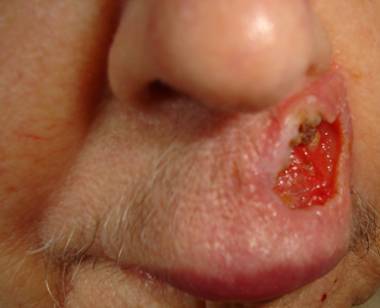
Photo 2 Hairs on the top lip
Photos’ 1 and 2 show the ulcer as well as numerous hairs on the top lip. The hairs made the choice of dressings / tape to secure dressings, difficult and shaving or clipping the hair was not an option.
Objective of wound care
- There was no chance of this ulcer ever healing so the main objectives were to:
- Reduce the ulcer pain;
- Fill the ulcer crater with a primary dressing that would ‘take up space,’ cover nerve endings, absorb exudates and not ‘stick’;
- Cover the ulcer and secure the primary dressing with a non-traumatic dressing i.e. a dressing that would not pull the hairs out of the skin on removal;
- Make sure the dressing stayed in place and did not interfere with eating and drinking;
- Ensure that as few dressing changes as possible would be required.
What did we do?
Fortunately the wound bed did not require cleaning. Even if it had it was unlikely that Ms. M.L. would have allowed any nurse to touch the ulcer. The lips and chin sometimes required a gentle wipe to remove dried exudates and / or food.
Morphine gel was put into the ulcer then a small piece of Aquacel was ‘dropped in’ to take up about 80% of the ulcer. (Photo 3) There was no packing or pushing to get it in.
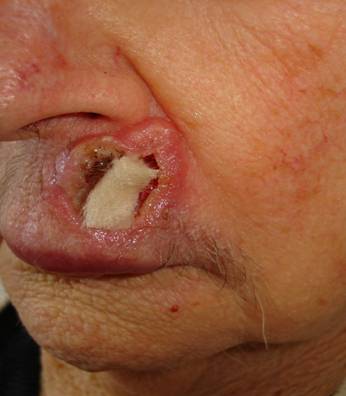
Photo 3 Aquacel in the ulcer
Aquacel is a primary wound dressing made from sodium carboxymethylcellulose.
The dressing absorbs and interacts with wound exudates to form a soft, hydrophilic, gas-permeable gel that traps bacteria and conforms to the contours of the wound.
http://www.dressings.org/Dressings/aquacel.html

Photo 4 Top lip covered with Mepilex Lite
We then covered the top lip with Mepilex Lite, (Photo 4) a conformable absorbent self-adhesive dressing which consists of a thin flexible sheet of absorbent hydrophilic polyurethane foam. The wound contact surface of the dressing is coated with a soft silicone adhesive layer which adheres to the peri-wound skin, retaining the Aquacel dressing in position.
http://www.dressings.org/Dressings/mepilex-lite.html
Did it work?
Aquacel was a perfect primary dressing as it was able to be ‘dropped into’ the cavity without touching the ulcer. Equally I believe an alginate would have been perfectly suitable.
The need to cover nerve endings, reduce pain and fill the deep cavity wound without ‘packing’ was necessary and quite successful. We followed manufacturer’s recommendations to fill about 80% of the ulcer to accommodate swelling from exudates. Aquacel was held in place with Mepilex Lite a secondary dressing.
Mepilex Lite was perfect for this lady’s frail, compromised skin. It hid an unsightly, embarrassing ulcer and did not interfere too much with eating and drinking. It was fairly easy and atraumatic to remove, unlike strong adhesive dressings and tapes which would no doubt have pulled the hairs out of Ms. M. L.’s skin, causing unnecessary pain.
There is no conflict of interest. I have not been paid by any company to write this article, nor am I paid to promote these products in any healthcare facility.
Some details have been altered slightly for patient confidentiality.
I am not qualified to comment on the pain management regime.


